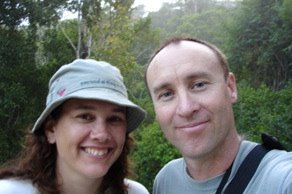Meeting Families
After that, one of the kids (4 of these, ranging from about 6 to 13, two girls, two boys) would read a passage from the Bible. They were proceeding in order and were still in Genesis (but had obviously read much of the rest many times before). After finishing, they would each have a chance to interpret that section themselves. Everyone participated. The first night I was skipped, but the next two nights I was asked to contribute. This was very difficult because the Bible is not written in the simple tenses and grammar that I understand well. In addition, answering should be using more complicated sentences with lots of “would haves” and “could haves”. They were very forgiving though, and it was “vale la pena”.
It was very interesting to me how I immediately appeared in their prayers, along with my co-workers who all met my family as well. By the second night, due to our conversations they knew all about Katie, and the rest of my family. So, of course that nights prayer included special prayers for Katie to be safe while she was away from me, and for my family to be understanding of my decision to come here and help the people of El Salvador, and that they and their dogs would be happy and healthy. Also that my Dad’s knee would heal quickly. All in all, a very moving experience.
This family was living in a fairly remote section of El Salvador, in a house with no electricity (candlelight for prayers, and meals). Yet they kept up with current world events better than many Americans with cable TV and high speed internet. They used a battery powered radio to get their news, and also to keep up on the soccer league in Spain (they were fans of Barcelona, and therefore didn’t like Madrid). We had very good conversations on the war in Iraq, my vocabulary is better in this area because I have discussed it quite a bit. El Salvador is one of the few countries who still have troops there to support the US.

